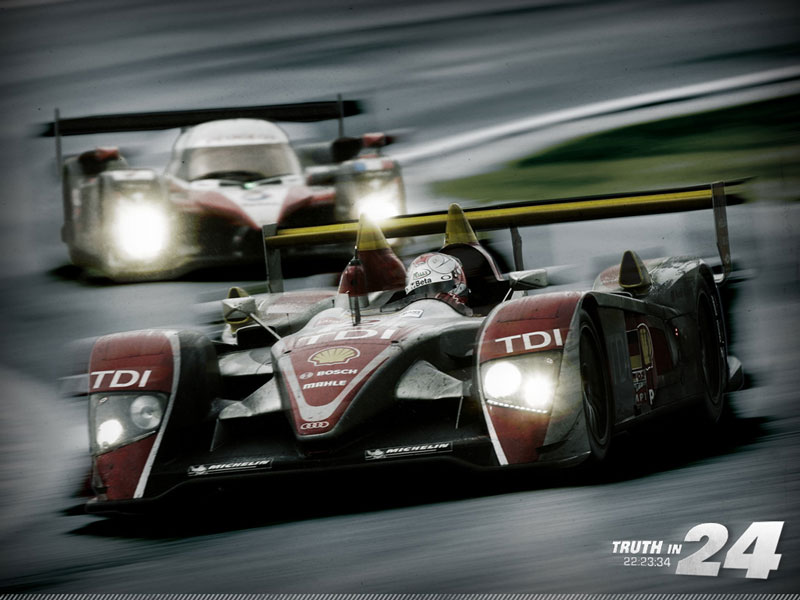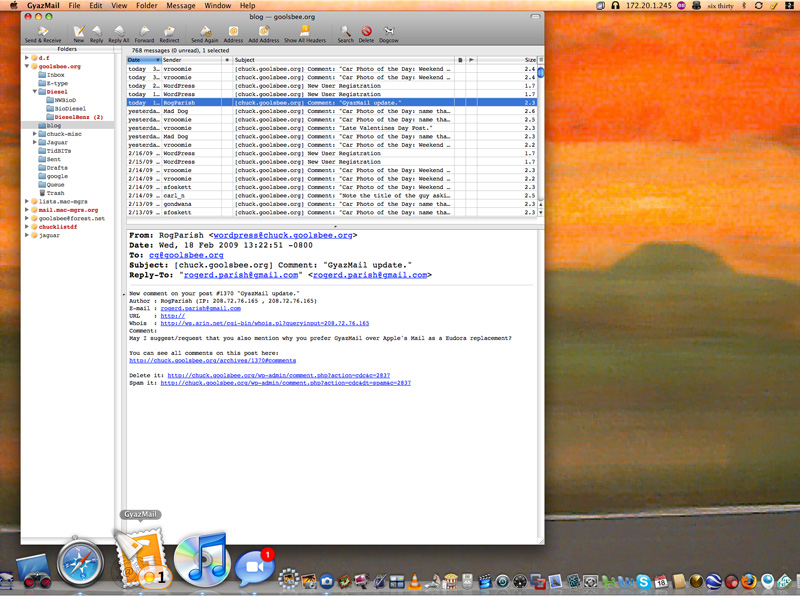
I just finished watching Truth in 24, and if you are a geadhead I have to say you owe it to yourself to watch. The 24 Hours of Le Mans is for me the only truly compelling event in motorsports. F1 just seems way too technical, delicate, and overdone. NASCAR reminds me of driving down the freeway, only with just left turns and more noise. Indy seems like an anachronism, or open wheel NASCAR. Le Mans however is completely different. It has deep history, combined with all the technicality and strategy you could imagine. They race, balls-out, rain or shine, in daylight and darkness, at speeds that boggle the mind, on a course made partially from public roads. The cars are all radically different, with four completely different classes on course simultaneously. The machines have to have seriously high top-end speed, while still being able to brake and turn at very low speeds. Best of all, the race is not a fixed distance, but merely hours on a clock. Endurance. The car has to be built to last, and the crews have to be able to keep it running, or rebuild it on the fly. Teamwork is vital. Engineering is critical. Driving skill is tested. Survival is as important as speed.
One item on my “bucket list” is to attend the event, by DRIVING there, ideally in the 65E. Meanwhile I have Steve McQueen’s iconic and epic Le Mans, and this wonderful documentary, Truth in 24. While nowhere near as compelling as McQueen’s classic, it has perhaps even better photography, which is saying a lot. It follows the 2008 Le Mans event from the perspective of Audi’s R10 teams. Despite having dominated Le Mans with their R8 and R10 cars over the past decade, Audi was viewed as the underdog last year as Peugeot had their Diesel-powered 908 HDI prototypes. The Peugeots were 3.5 seconds faster per lap around Circuit de la Sarthe. While that may not sound like much, over 24 hours that adds up to a daunting lead. How the Audi team pulls off a win is documented in this film. The difference at the end comes down to one decision, by one very tired engineer, who is being second-guessed by everyone at the moment, but he sticks to his guns. To show how truly grueling this event is, he savors his victory by walking to a quiet place and sitting down to rest, outside the whirlwind of everyone else spraying champagne.
My only complaints about this film is the obvious hand of Audi’s marketing department, and the trademark ‘NFL Films’ style and soundtrack, but if you can do your best to ignore those and soak in the excellent photography and the raw, “unedited for cleanliness” character of the people, the cars, and the emotions you really get a sense of the endurance part of endurance racing. It impossible to watch all of the event, but this film comes very close to doing so, albeit from the perspective of just one team.
One highlight that sticks in my mind, which oddly is not at all visual, but is just a straight sequence where driver Alan McNish takes us on a “guided tour” of the course, while sitting in a chair and watching a video taken from a car on-course. He relates the gear changes, the speeds, the line of the course, which apexes to hit, and which once to miss, where the car will fight you, and where you have to let it go. The video shown is taken at speed and the rate at which the course comes at you is mind-bending. He relates it all in real-time and is breathless by the end. Now imagine doing that for hours on end, through rain, darkness, harsh low-angle sunlight, and traffic.
Amazing.
Another highlight is a passage near the beginning where they briefly talk about the amazingly quiet TDI engine. The Diesel race cars are shockingly quiet. To anyone accustomed to the scream and roar of a typical race car going by the silent “whoosh” of the TDI is startling. More startling as “quiet” is not usually the first thing that comes to mind when you think of Diesel! Ulrich Baretzky, the head of the development of this engine says something very interesting in the film: “Noise is a form of energy, the less you hear the more you use in propulsion.”
This film is being shown on cable TV here in the USA, but best of all you can download it for FREE from Apple’s iTunes Store.
If you want a preview, head on over to the film’s official website: www.truthin24.com.
(Thanks go to reader Wil Langford for pointing me to this!)



